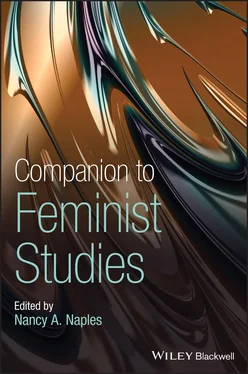While feminist studies has a long history, it became institutionalized in academia beginning in the 1970s, through courses offered in different disciplines like English, History, Sociology, or Anthropology. These efforts contributed to cross‐disciplinary advocacy for the establishment of Women's Studies programs where faculty designed interdisciplinary courses in response to the deepening intellectual project. In the US, Feminist Studies has found an institutional foothold in some universities as a stand‐alone program or department. The Feminist Studies Program at the University of California, Santa Cruz was founded in 2013. They describe their mission as “challenging existing disciplinary boundaries and fostering a reconsideration of the relationships between knowledge, power, and expertise” ( https://feministstudies.ucsc.edu/graduate). It is now a department that trains students for academic careers as well as for public policy and human rights advocacy and research. In describing its graduate education in Feminist Studies, it notes that:
The roots of Feminist Studies lie in the study of women's experiences and a critique of their neglect in knowledge production. But the name “Feminist Studies” reflects the fact that the subject matter includes more than women: research and teaching focus on the ways that relations of gender, intersecting with race, class, ethnicity, sexuality, nationality, age, religion, ability, and other categories of difference, are embedded in social, political, and cultural formations. Feminist Studies encompasses teaching and research interests in men and masculinities and sexualities, as well as women.
(Feminist Studies n.d., UCSB)
Graduate training in Feminist Studies draws on diverse critical epistemologies and interdisciplinary approaches. For example, the University of Washington's Graduate Program in Feminist Studies centers “Intersectional, Decolonial, Indigenous, Queer and Transnational feminisms” and encourages “research informed by Black Studies, Latina/o Studies, Asian American Studies, Latin America, East Asia and South Asia Studies and the disciplines including Anthropology, Cultural Studies, History, Political Science, Psychology and Sociology” ( https://gwss.washington.edu/feminist‐studies‐doctoral‐program).
The US has a strong emphasis on undergraduate training, while in other countries, the focus has been primarily on graduate education (see Tambe and Montague in Companion to Women's and Gender Studies , 2020). Furthermore, as Tambe and Montague note, feminists in other countries have had different relationships with the state. For example, feminist perspectives have been more effectively integrated in state governance structures than in the US. For example, in Australia, feminist activists were able to incorporate their activism into the state as “femocrats” where they engaged with policy construction and implementation across different arenas, including applying a feminist framework to review of the general state budget (Eisenstein 1989; Mazur 2001; Watson 1990). While their influence has waned over the years (Outshoorn and Kantola 2007), feminist activists have found footholds in other countries where, for example, they have succeeded in passing statutes for greater representation of women in both elected and other governmental positions in France, Pacific Islands, the UK, Scandinavia, and countries in Latin America and Africa, among others (see, for example, Arendt 2018; Baker 2019; Barnes and Córdova 2016; Dahlerup and Freidenvall 2005; Hughes et al. 2017; Johnson Ross 2019; Opello 2006).
Since the field of Feminist Studies draws insights from feminist scholars and activists from many different disciplinary and interdisciplinary sites and diverse local, national, and regional contexts, it is challenging, to say the least, to ensure all voices, perspectives, and contributions are represented. Our solution is to focus attention on many of these contributions by organizing the Companion to Feminist Studies around three different dimensions that are key components of the field and transcend these differences: Feminist Epistemologies and Its Discontents, Methodological Diversity, and Feminist Praxis.
The Diversity of Epistemologies, Methodologies, and Feminist Praxis
Part II, entitled “Feminist Epistemologies and Its Discontents,” presents 10 different theoretical frameworks that have diverse historical and political origin stories and investments. It opens with an examination of gender essentialism, one of the most persistent approaches to the analysis of gender and sexual differences ( Chapter 2). Author Sheila Greene begins with a discussion of Graeco‐Roman arguments about essential differences between women and men that positions men as superior by nature to women. Women's reproductive capacity has often been the basis for her construction as closer to “nature,” while men's presume greater intellectual capacity positions them as creators of culture and academic advancement. Greene traces the continuity of this framing over time and how it continues to be “deeply embedded in Western scholarship.” For example, contemporary biologically determinist approaches center the significance of genes, hormones, and brain differences in contributing to essentialist gender differences. Feminists have challenged these reductive approaches and point out the interaction of biological and other social, cultural, and environmental factors in shaping human diversity (see, e.g. Davis 2015; Fausto‐Sterling 2000; Keller and Longino 1996; Udry 2001).
In Chapter 3, Elisabeth Armstrong examines the development and divergence between Marxist and Socialist Feminism. Marxist feminism was articulated in the late 1960s and early 1970s by feminists who adapted Karl Marx's analysis of capitalism to incorporate the significance of women's unpaid labor in the home for supporting the economic exploitation of workers. Socialist feminism quickly followed as feminists engaged with analysis of patriarchy as a separate system of exploitation.
Chapter 4provides a fascinating discussion of the origins and debates in “Radical and Cultural Feminisms.” Lauren Rosewarne examines the activism of radical feminists and radical feminist theoretical analyses from the late 1960s. She notes that one major tenet of radical feminism is that “women are subordinated … [as] an oppressed class ; a sex‐class … caused by patriarchy.” She explains that “radical feminism aimed to dismantle not only patriarchy but each of the social, cultural, political, and economic structures that benefited from – and supported – male authority.” As noted above, feminists informed by both radical analyses of patriarchy and Marxist critiques of capitalism were in the forefront of developing socialist feminism.
Rosewarne outlines key tenets and critiques of radical feminism, then moves to discuss the difference between radical and cultural feminism. She defines cultural feminism as:
a theory which describes that there are fundamental personality differences between men and women, and that women's differences are special … Underlying this cultural feminist theory was a matriarchal vision – the idea of a society of strong women guided by essential female concerns and values. These included, most importantly, pacifism, co‐operation, non‐violent settlement of differences, and a harmonious regulation of public life.
(Tandon 2008, p. 52)
While radical feminism orients toward separatism and the elimination of the sex‐class system, “cultural feminism was a countercultural movement aimed at reversing the cultural valuation of the male and the devaluation of the female” (Echols 1989, p. 6, quoted in Rosenwarne in this volume). Alice Echols argues that “radical feminists were typically social constructionists who wanted to render gender irrelevant, while cultural feminists were generally essentialists who sought to celebrate femaleness” (ibid).
Читать дальше












